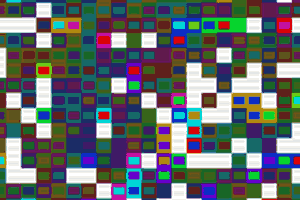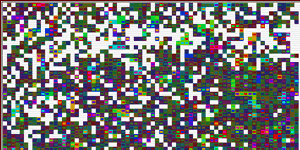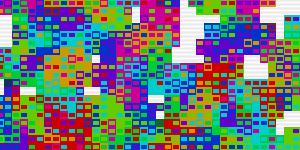/flash/alife.swf
Weblog ALife 2: Choosing Weblog Topics
What makes a good topic for a personal site or Weblog? This question faces everyone who considers creating a personal site. Will people be interested in my new weblog? Will they link to it? Will it be worth the effort?
Weblogs don't prosper in isolation; they grow and evolve in clusters of related sites. For example, a big cluster of sites has grown up in the shade of Dave Winer's Scripting News. A different cluster (sometimes called the Blogger A-list) has grown out from the Blogger home page and the weblogs of Pyra founders Evan Williams and Meg Hourihan. Jeff Zeldman is part of a circle of independent Web designers, Derek Powazek is the focus of a circle of digital storytellers, Jill Walker is called the mother of the Norwegian-flavored weblog community.
How hard is it for cluster like these to emerge? Do they reflect something intrinsic about weblogs, or are they just social cliques? Are clusters rare exceptions that happen to be successful, or are they a natural outgrowth of weblogging?
A Simple Approach
Let's take a worst-case scenario for disorganization: hundreds of new weblogs, each with its own interests, all starting simultaneously. It's an artificial notion, but this might actually be observed in an educational context. Imagine, then, that we have a room filled with hundreds of new student webloggers.
We'll symbolize topical interests with colors; blue might denote Tech, "red" might mean "20-something life", tan might mean "right-wing politics", and so forth.
Each writer keeps a list of up to eight related weblogs. These are weblogs they read every day, and to which they link frequently. We symbolize this special relationship by drawing a map of our weblog community in which related weblogs are drawn next to each other on a grid.
The map of real weblog communities is, of course, less regular than a lattice. It's not necessarily planar. This particular formulation makes for a good visualization, and it's a convenient starting place. I doubt that relaxing this restriction will change the results; do the experiment and let me know what you observe.
Each (sim) student must choose a set of related weblogs from their notional classmates. Since everyone is new, we start by having each student "adopt" whoever happens to be sitting nearby.

Each weblog has a primary interest (displayed as color of its outer square) and a secondary interest (the color of a smaller square inside it). A few lucky people find out that they're sitting right next to strangers who happen to share their interests. They're happy (and their weblogs have bright colors), because from the outset they find themselves with engaged readers who share their interests. Their daily reading always includes some interesting sites, and those sites will often link intelligently to their own.
Those who find themselves without at least two like-minded neighbors are unhappy (and their weblogs have dim colors). Here's the way things look right away -- a sea of chaos, mostly unhappy.

Unhappy sites are less likely to enjoy their daily Web reading, because the sites they have to visit don't address their core concerns. When the related sites link to their writing, the links are more likely to be feeble or misleading, since the authors don't really understand or care about their interests. (You see this happen in the real world when people try to build weblog communities artificially -- circles of webloggers who go to school together or who come from the same neighborhood, but who really have little in common.)
Our standard of happiness is very modest: a weblogger can be happy if their list of related sites contains six boring sites and merely two good ones. Unhappiness sets in only if we are totally isolated, or have only one related site with any interest in common.
Every day, students read and write their weblog entries and explore links in their neighborhood. Happy weblogs -- those with at least two related weblogs in the neighborhood -- stay put. Unhappy weblogs look around for an empty place in the neighborhood where they would be happier. At first, almost nobody is happy. After three weeks, about half the weblogs are happy. It takes two or three months for (almost) everybody to find a place where they're happy.

Clusters
Many years ago, Thomas Schelling did a series of famous alife experiments very much like this one, in order to understand segregation in housing. He discovered that, using rules very similar to these, a population of red and blue sims would form segregated enclaves, even if their only desire was to have some neighbors of the same color. A red sim was happy if it lived next to just one or two red sims; still, in the end Schelling found that the sims tended to coalesce into ethnically pure regions.
Our experiment is not quite the same. Schelling studied two races; we model 6 or 10 or more distinct topics. Most people consider themseklves members of only one race, but we can have lots of weblog topics, and we can easily find ourselves interested in several.
Nonetheless, our sims sort themselves quite quickly into topical clusters. The secondary interests play an interesting role in helping weblogs find happiness, but they play an even more interesting role in browsing. Notice, for example, the big green cluster in the bottom-center of the final "happy" state. Above and to the right, there's a small cluster of purple sites, buffered by sites interested in both purple and green. This is exactly what you would do if you wanted to plan a weblog community. For example, if you wanted to connected Tech sites to Culture sites, you'd look for some cultural critics and tech-heavy creatives to mediate the transition. But there's no master plane at work here; the pattern simply emerges from a strategy of seeking to avoid the worst-case.
One of the nightmare scenarios for the weblog world, in the long run, is a complete breakdown into isolated islands. The right-wing weblogs would link only to other conservative pundits, the left-wing weblogs would ignore them, and soon everyone would read and link only to very similar weblogs. That's not what happened here. Instead, secondary interests lead to gradual transitions in topic and orientation, and also make weblogs happy with their traffic long before they coalesce into a isolated, pure clusters. There's not much need for all the green clusters to coalesce into one big green lump; small clusters satisfy themselves with the help of secondary interests from their neighbors.